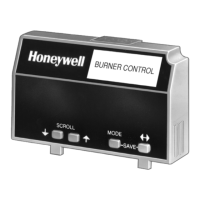7800 SERIES S7800A KEYBOARD DISPLAY MODULE
65-009
0-6
14
Table 5. Keyboard Display Module Sequence and Status Hold Messages. (Continued)
Sequence
S
tat
us
PURGE HOLD: T18
(Low Fire Switch)
The KDM indicates the burner status and that the Low Fire Switch is not closed. The firing rate motor is
driving to its Low Fire position in preparation for Ignition Trials. If this time exceeds four minutes and
fifteen seconds, the relay module locks out.
PURGE HOLD: T7
(Running Interlock)
The KDM indicates the burner status and that the Running Interlock is not closed. The sequence does
not advance to ignition until the Running Interlock proves closed. If this time exceeds 30 seconds, the
relay module locks out.
PILOT IGN mm:ss
The KDM indicates the burner status, PILOT IGN, and the timing of the PILOT IGN trial begins, in
seconds. During this period, the relay module permits the pilot valve to open and the pilot flame to
establish.
If the relay module is in a PILOT HOLD status, the following conditions could exist:
PILOT HOLD: TEST
(Run/Test Switch)
The KDM indicates the burner status, PILOT IGN, and that the Run/Test Switch is in the TEST position.
The sequence does not continue until the Run/Test Switch is placed in the RUN position.
MAIN IGN mm:ss
The KDM indicates the burner status, MAIN IGN, and the timing of the MAIN IGN trial begins, in
seconds. During this period, the relay module permits the main valve to open and the main flame to
establish.
RUN The KDM indicates the burner status, RUN, which is the period of time after the Ignition Trials and
before the operating controller setpoint is reached. During this time, the burner is firing under control of
the firing rate control.
If the relay module is in a RUN HOLD status, the following condition could exist:
RUN LOWFIRE: TEST
(Run/Test Switch)
The KDM indicates the burner status and that the Run/Test Switch is in the TEST position. Normal
modulation or operation does not continue until the Run/Test Switch is placed in the RUN position.
POSTPURGE mm:ss
The KDM indicates the burner status, POSTPURGE, which is the period of time after the RUN period
when the blower motor continues to run. The timing of the POSTPURGE period is fifteen seconds.
Waiting for connection... The KDM has power but is waiting to receive a signal from the relay module to continue operation.
RESET/ALARM TEST
The KDM indicates the burner status, RESET/ALARM TEST. This condition indicates that the reset
button is pressed. If it is held for more than four seconds, the alarm output is energized. The alarm
output is de-energized when the reset button is released.
Additional Sequence Status Information When An Expanded Annunciator is Connected to the Relay Module:
BURNER OFF: T6
(Burner Switch)
The KDM indicates the Burner Switch is not closed. The burner sequence does not advance to
PREPURGE until the Burner Switch closes.
STANDBY
The KDM indicates the burner status, STANDBY, and that the Operating Control is not closed. The
burner sequence does not advance to PREPURGE until the Operating Control closes.
STANDBY HOLD: T6
(EA Hold Message)
The KDM indicates the burner status, STANDBY, and that a limit is not closed. The burner sequence
does not advance to PREPURGE until one or all limits close downstream from the Operating Control.
STANDBY HOLD: T6
(Circuit Fault)
The KDM indicates the burner status, STANDBY, and that the control input is not closed. The burner
sequence does not advance to PREPURGE until the control input closes.
The S7800 provides diagnostic information to aid the service
mechanic in obtaining information when troubleshooting the
system. See Table 6 for information on accessing historical
and diagnostic selectable messages. Information available in
the Diagnostic Information includes Device Type, Device
Suffix, Software Revision, Manufacturing Code, Flame
Amplifier Type, Flame Failure Response Time
(FFRT),
Selectable Jumper Configuration Status, Run/Test Switch
Status and Terminal Status.
Historical Information Index
The S7800 displays historical information for the six most
recent lockouts. Each of the six lockout records retains the
cycle when the fault occurred, a fault code, a fault message,
and burner status when the fault occurred. See Table 6. The
Fault History is NOT available if the Service Call Feature
is
active.

